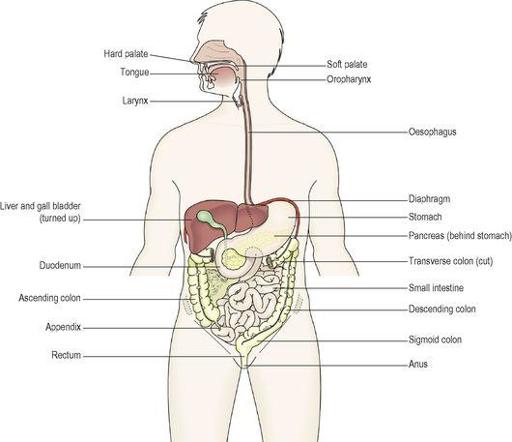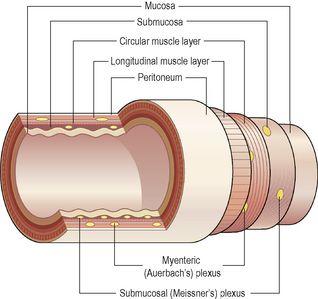Read Ross & Wilson Anatomy and Physiology in Health and Illness Online
Authors: Anne Waugh,Allison Grant
Tags: #Medical, #Nursing, #General, #Anatomy
Ross & Wilson Anatomy and Physiology in Health and Illness (129 page)

Small intestine
293
Functions of the small intestine
295
Chemical digestion in the small intestine
295
Absorption of nutrients
296
Large intestine, rectum and anal canal
297
Functions of the large intestine, rectum and anal canal
299
Pancreas
299
Liver
300
Functions of the liver
301
Biliary tract
303
Bile ducts
303
Gall bladder
304
Summary of digestion and absorption of nutrients
304
Metabolism
305
Carbohydrate metabolism
307
Protein metabolism
308
Fat metabolism
310
Diseases of the mouth
311
Diseases of the pharynx
312
Diseases of the salivary glands
312
Diseases of the oesophagus
313
Diseases of the stomach
314
Diseases of the intestines
316
Diseases of the pancreas
323
Diseases of the liver
324
Diseases of the gall bladder and bile ducts
326
ANIMATIONS
12.1
The alimentary canal
278
12.2
Oesophagus
288
12.3
Mouth: chewing and preparation for swallowing
288
12.4
Pharynx
289
12.5
Peristalsis
289
12.6
Stomach
291
12.7
Stomach: secretion of pepsinogen
291
12.8
Small intestine
294
12.9
Summary of digestion
297
12.10
Large intestine
298
12.11
Hepatic portal circulation
301
12.12
Biliary tract and secretion of bile
303
12.13
Factors influencing metabolic rate
306
12.14
Glycolysis
308
The digestive system is the collective name used to describe the
alimentary canal
, its
accessory organs
and a variety of digestive processes that take place at different levels in the canal to prepare food eaten in the diet for absorption. The alimentary canal begins at the mouth, passes through the thorax, abdomen and pelvis and ends at the anus (
Fig. 12.1
). It has a general structure which is modified at different levels to provide for the processes occurring at each level (
Fig. 12.2
). The digestive processes gradually break down the foods eaten until they are in a form suitable for absorption. For example, meat, even when cooked, is chemically too complex to be absorbed from the alimentary canal. Digestion releases its constituents: amino acids, mineral salts, fat and vitamins. Digestive
enzymes
(
p. 24
) that effect these changes are secreted into the canal by specialised glands, some of which are in the walls of the canal and some outside the canal, but with ducts leading into it.
Figure 12.1
The digestive system.
Figure 12.2
General structure of the alimentary canal.
After absorption, nutrients are used to synthesise body constituents. They provide the raw materials for the manufacture of new cells, hormones and enzymes, and the energy needed for these and other processes and for the disposal of waste materials.
The activities in the digestive system can be grouped under five main headings.
Ingestion
This is the taking of food into the alimentary tract, i.e. eating and drinking.
Propulsion
This mixes and moves the contents along the alimentary tract.
Digestion
This consists of:
•
mechanical breakdown
of food by, e.g. mastication (chewing)
•
chemical digestion
of food into small molecules by enzymes present in secretions produced by glands and accessory organs of the digestive system.
Absorption
This is the process by which digested food substances pass through the walls of some organs of the alimentary canal into the blood and lymph capillaries for circulation and use by body cells.
Elimination
Food substances that have been eaten but cannot be digested and absorbed are excreted from the alimentary canal as
faeces
by the process of
defaecation
.
The fate of absorbed nutrients and how they are used by the body is then explored. In the final section disorders of the digestive system are considered.
Organs of the digestive system (
Fig. 12.1
)
Learning outcomes
After studying this section, you should be able to:
identify the main organs of the alimentary canal
list the accessory organs of digestion.



